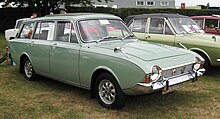Ford Corsair
| ford | |
|---|---|
|
Ford Corsair (1965)
|
|
| Corsair | |
| Production period: | 1963-1970 |
| Class : | Middle class |
| Body versions : | Sedan , station wagon , convertible |
| Engines: |
Petrol engines : 1.5–2.0 liters (44–61 kW) |
| Length: | 4490 mm |
| Width: | 1613 mm |
| Height: | 1410 mm |
| Wheelbase : | 2565 mm |
| Empty weight : | 995 kg |
| Previous model | Ford Consul Classic |
| successor | Cortina Mk III (TC) |
The Ford Corsair was a mid- range car that Ford England produced from 1963 to 1970 as a 2 or 4-door sedan, a 5-door station wagon and a 2-door convertible. The early models used styling details from the 1961 and 1962 Ford Thunderbird. There was also a convertible version made by Crayford Engineering , which is very rare today. A 3-door station wagon was also offered in some export markets.
The Corsair was created on the extended floor pan of the Cortina MK1 , with which it also had many mechanical features. The Corsair had an unusual and bold styling at the time, with a horizontal, V-shaped crease at the front with round headlights inserted into it, giving the car an aerodynamic look. The jet-shaped appearance continued to the rear, where the car ended in strongly offset vertical tail lights that are reminiscent of tail fins .
The car was initially offered with the larger, 60 bhp (44 kW) engine with 1,498 cm³ ( Ford Kent type , with single carburetor), which was also installed in the smaller Cortina as a standard and GT version. In 1964 Tony Brooks team set 13 speed world records in a Kent four-cylinder in-line engine in Monza , Italy , with an average speed of 159 km / h over 24,030 km (15,000 mls) in the class up to 1500 cc. In 1965 the Corsair was equipped with new V4 engines. First there was an engine with 1663 cm³ displacement; In 1966 a more powerful 1996 cc engine with 61 kW (82 hp) was added, which was also used in the new Ford Zephyr Mk IV .
A station wagon manufactured by Abbott of Farnham expanded the range in 1966, and Crayford also manufactured several convertibles. From 1967 the Corsair, like the smaller sister model Cortina, was available in an executive version, a 2000 E with flanks without chrome trim, special hubcaps, a vinyl roof and improved interior fittings.
The performance of the Corsair was unimpressive; the 2.0-liter V4 engine accelerated it to a maximum of 153 km / h. Some enthusiasts tuned the car, but there was a popular rumor that the wedge-shaped nose made the car so light at the front at speeds over 130 km / h that it was really dangerous to drive. Probably this is an unjustified rumor that was finally taken ad absurdum when the Corsair reached the above-mentioned world records in Monza, where it drove faster than 160 km / h for hours without any noticeable effect on the steering.
In 1970 the Corsair was replaced by the Cortina Mk3 , which - now enlarged - took the place of the mid-range car in the Ford range. A new, smaller model, the Escort, filled the void that old Cortina had left. The new Capri replaced the high-performance versions. A total of around 310,000 Corsair were built in six years.
Ford Corsair Australia
From 1989 to 1992, the Corsair name was used for a version of the Nissan Pintara (known as Project Matilda ) by Ford Australia . The vehicle was available as a sedan or hatchback sedan and was intended to replace the Telstar based on the Mazda 626 , which was made in Japan . Both vehicles were offered in parallel for a few years, with the Telstar then only available as a hatchback model in the high-performance TX5 version. When Nissan closed its Australian plant in 1992, the Corsair was discontinued and the Japan-made Telstar again took the place of the mid-range car in the Australian Ford range until it was replaced by the Mondeo in 1995 . The Corsair was available with 2.0-liter (CA20E) and 2.4-liter (KA24E) engines, in GL and Ghia versions.


